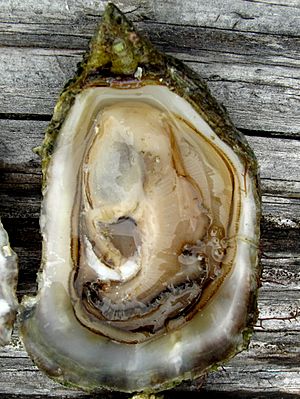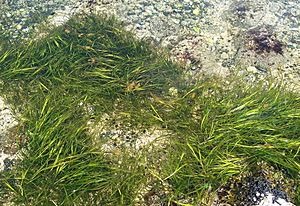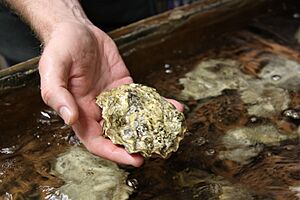Netarts Bay facts for kids
Netarts Bay is a beautiful bay on the northern Oregon Coast in the United States. It's located about 5 miles (8.0 km) southwest of a town called Tillamook. The small community of Netarts is on the north side of the bay.
On the south side, you'll find the Netarts Bay Shellfish Preserve, which is managed by the Oregon Department of Fish and Wildlife. The long strip of sand on the west side of the bay is actually part of Cape Lookout State Park.
Netarts Bay is about 5 miles (8.0 km) long and 1.5 miles (2.4 km) wide. It covers a total area of 2,325 acres (9.41 square kilometers), making it the seventh largest bay in Oregon. About one-third of this area is always underwater. The rest is land that gets covered and uncovered by the tides. The water level can change by as much as 9 feet (3 meters) between high and low tide!
The bay is part of a larger area of land, called a watershed, that is 13 square miles (34 square kilometers) big. At least 16 small creeks flow into the bay, bringing fresh water from the land.
Contents
How Netarts Bay Works
Tides and Water Flow
Like other bays along the Oregon Coast, Netarts Bay has two high tides and two low tides each day. This is called a semi-diurnal tide.
When the tide is at its lowest, the bay holds about 113 million cubic feet of water. When the tide is at its highest, it holds about 450 million cubic feet. This means a huge amount of water, about 33 million cubic feet, moves in and out with each tide!
The water level can change by 5 to 9 feet (1.5 to 3 meters). This strong tidal movement helps to flush out about 40% to 90% of the bay's water during each tide cycle. On average, the water in the bay completely changes about twice a day. This keeps the bay's water well-mixed, so the temperature and saltiness are pretty much the same from top to bottom.
Sand Movement and Erosion
About 2,500 tons of sand and other materials flow into the bay each year. This means the bay is slowly filling up with sediment over time.
Strong weather events, like El Niño, can cause a lot of erosion. During big El Niño events, as much as 70,000 cubic meters of sand can be moved around. Waves from the southwest erode the southern part of the sand spit. This sand then moves northward, causing the bay's entrance to shift over time. Cape Lookout State Park is in an area that experiences a lot of this erosion.
The Bay's Ancient History
Over the last 5 million years, the land around Netarts Bay was shaped by erosion. This created the natural bowl where the bay now sits.
Scientists have studied sediment cores from the bay. These cores are like long tubes of mud and sand taken from the bottom. They show evidence of very large earthquakes that happened regularly in this area. These earthquakes are part of the Cascadia Subduction Zone.
The sediment cores suggest that major earthquakes have happened every 400 to 600 years. At least four big quakes have occurred in the last 3,000 years. After these earthquakes, the land would sink. This is called coseismic subsidence. Layers of sand from tsunami waves also show these events.
Native American settlements along nearby rivers also show evidence of land sinking by 1 to 2 meters after these earthquakes.
Life in Netarts Bay
Shellfish and Oysters
The Olympia oyster is the only type of oyster that naturally lives on the West Coast of North America. People have been harvesting these oysters for at least 4,000 years!
In the 1860s, there was a big business for Olympia oysters in Netarts Bay. But too much harvesting caused the oyster population to crash. By 1954, there were no known natural Olympia oyster populations left in the bay.
Scientists tried to bring them back in the 1990s by planting millions of young oysters. While they didn't return to their old numbers, some transplanted oysters were found in 2004. Small groups of naturally growing oysters have also been seen in the bay.
Restoring Olympia oysters is important for many reasons. People enjoy eating them, and they could bring economic benefits. Also, oysters help the bay's ecosystem by filtering water and providing homes for other creatures.
Four different kinds of bay clams also live in Netarts Bay.
Marine Plants
The main plants that produce food in the bay are eelgrass, tiny diatoms, and sea lettuce. Most of these plants grow on the mudflats, which make up about two-thirds of Netarts Bay.
Eelgrass beds are found in the muddy areas that are sometimes covered by water and sometimes not. They are very important. Eelgrass provides food for birds and habitat for young fish. It also helps shape the bay's environment. Oysters can help eelgrass grow by filtering the water, which lets more light reach the plants.
Diatoms are tiny, single-celled algae. They live on the bottom of the bay, in the water, and on other marine plants. There are 336 different types of diatoms found in Netarts Bay!
Sea lettuce, a type of green algae, usually grows in the summer.
Japanese eelgrass is a species that was brought to the area by accident. It likely came with shipments of Pacific oyster seeds in the early 1900s.
Native Americans and Netarts Bay
Netarts Bay and its sand spit were historically home to the Tillamook Indians. Their territory stretched from Tillamook Head in the north to the Nestucca River in the south. It went from the Pacific Ocean in the west to the Coast Range mountains in the east.
Cape Lookout State Park has 13 possible ancient sites, including 6 on the Netarts sand spit. These sites might represent one to three major villages. Digs at one site, Netarts Sandspit Village, show it was a large Tillamook village. It was used at least three times between 1300 and 1700 A.D.
Archaeologists found evidence of semi-underground houses made of cedar planks. They also found many fire pits and large piles of discarded shells and bones, called middens. The village may have had 30 to 40 houses. It's considered a very important historical site on the Oregon Coast.
Many artifacts were found during excavations in the 1950s. These included tools and objects made from bone and antler, such as wedges, needles, and harpoon parts. They also found bone carvings with faces. Stone tools like arrowheads, scrapers, and hammerstones were also discovered. In the most recent layers, they found trade goods like rusted iron, a copper pendant, and pieces of Chinese porcelain.
The middens were very deep, some over 2 meters (6.5 feet) deep. Scientists found over 67,000 bones from at least 59 different animals. These included birds, fish, shellfish, sea lions, sea otters, seals, porpoises, whales, elk, deer, and beavers. This shows the Tillamook people used many different resources from the bay and surrounding areas.
They harvested a lot of Dungeness crabs, including many young crabs. It's thought they collected crabs and clams using rake-like tools during low tide.
Early European Settlers
Europeans likely started having more contact with the Native Americans in the late 1700s. By the time Lewis and Clark arrived in 1806, Native Americans already had firearms and metal tools.
The first European settlers arrived in Netarts Bay in 1865. Records show that native Olympia oysters were very plentiful in the bay. Oyster harvesting by European settlers began as early as 1868, and some oysters were even sent to San Francisco.
Historical accounts mention a small town called Oysterville in the bay during this time. The bay was sometimes even called "Oyster Bay." By 1903, almost all the shoreline of the sand spit was claimed by settlers. However, by 1920, most homes on the sand spit were gone. New growth then focused on the community of Netarts on the northeast side of the bay.
A commercial oyster farming business operated from 1930 to 1957. But it collapsed in 1957 due to the accidental introduction of a harmful snail called the Japanese oyster drill.
Ocean Acidification
Impact on Oysters
The oyster industry on the West Coast of North America mostly relies on the Pacific Oyster. There are only a few places where these oysters naturally reproduce. This means oyster farms depend on hatcheries to raise young oysters.
Whiskey Creek Shellfish Hatchery, located in Netarts Bay, is one of the largest suppliers of young oysters for the industry. In 2007, the hatchery experienced massive die-offs of young oysters. Similar problems happened at other hatcheries.
Researchers from Oregon State University worked with the hatchery. They discovered that the die-offs were linked to ocean acidification. This happens when the ocean absorbs too much carbon dioxide from the atmosphere, making the water more acidic.
They found that the first 48 hours of an oyster's life are very important. This is when the oyster builds its first shell. During this time, young oysters are very vulnerable to acidic water. This research helped the hatchery improve survival rates by treating the incoming water. This work at Whiskey Creek Hatchery has taught us a lot about how ocean acidification affects sea creatures.
Monitoring Water Quality
Today, there are real-time water quality monitoring systems. These systems help oyster farmers and scientists track changes in the bay's water. They measure things like how acidic the water is.
This information is available online. Regional ocean observing systems, like NANOOS, help collect this data. They aim to provide helpful information for shellfish farmers and the public.
Special devices called "burkolators" measure the water quality. They were invented by an OSU researcher named Dr. Burke Hales. These devices are now used at five shellfish hatcheries along the U.S. West Coast to monitor the incoming water. You can even see live data from these burkolators on the NANOOS website.
Effects on the Shellfish Industry
Most shellfish growers have seen the effects of ocean acidification on their businesses. A survey of 86 shellfish growers found that 85% believe ocean acidification is a problem affecting them today. And 95% think it will affect future generations.
Young oysters are generally more sensitive to acidic water than adult oysters. This means the early stages of oyster farming are more vulnerable. Shellfish growers must constantly adapt to changes in ocean chemistry. This makes their business more uncertain due to climate change.




